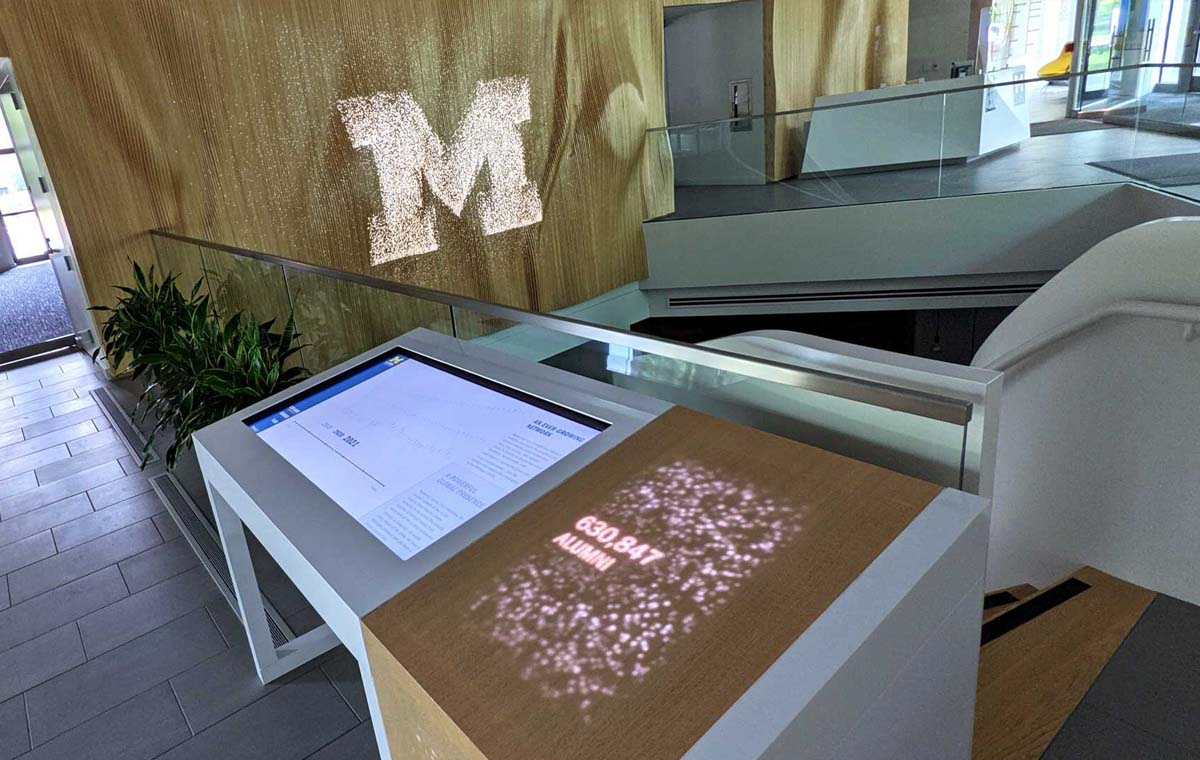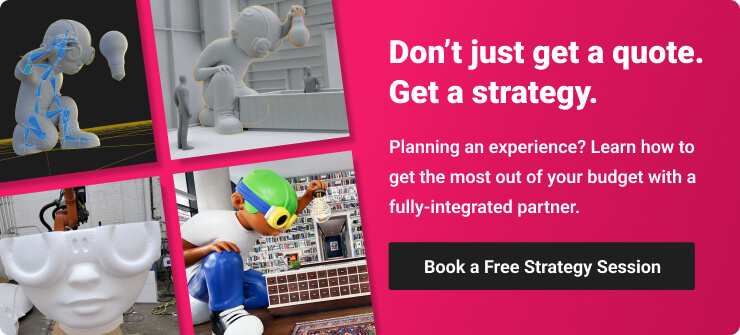Big tech really knows how to design commercial interiors, don’t they? From Pixar’s Atrium to Apple’s Spaceship Campus to Microsoft’s Treehouse meeting rooms, these brands understand how to (sometimes literally) elevate a workspace. But you don’t have to be a big tech company to have an innovative commercial interior.
In fact, from corporate offices to healthcare and educational institutions, airports to retailers, the importance of intentionally designed commercial interiors has never been greater. Beyond basic functionality, today's commercial environments are expected to foster meaningful connections, provide a tailored immersive experience, boost employee morale, and reinforce corporate values through visual storytelling.
The following trends reflect how forward-thinking brands are reimagining interiors to create inspiring experiences that strengthen company culture and enhance their relationships with employees, clients, and communities.

Why Rethink Commercial Interiors?
As ‘environments as experiences’ become more the norm than the exception, commercial interiors need to level up their designs to meet customer, employee, and guest expectations. This is true for traditionally design-forward environments like hotels, but equally so for airports, universities, hospitals, and stadiums. Brands and institutions must adapt their spaces to promote inclusivity – making it easier for the sensory- or mobility-impaired visitor to not only navigate but fully experience the space. Custom interiors must also respond to cultural and lifestyle changes, such as adding hand sanitizing stations, incorporating more natural light, or providing healthier food and beverage options. And finally, today’s commercial interiors should integrate advances in technology that can improve visitors’ experience and help them deliver an immersive and unforgettable experience.
5 Trends to Watch in Commercial Interiors
Inclusive Design
Spaces are being designed to be accessible and comfortable for all, regardless of age, gender, ability, or ethnicity. From more diverse representation in visuals to better color contrast and larger fonts on wayfinding graphics and signage to thoughtful choices when it comes to seating options for larger and differently-abled bodies, considering inclusivity when it comes to designing a commercial interior is not only the right thing to do, it’s the smart thing to do. Failing to accommodate these populations is alienating a significant percentage of potential customers and can reflect poorly on your brand.
One inspiring example is Starbucks’ Signing Stores in Japan, Malaysia, China, and Washington, D.C. These locations provide deaf or hard-of-hearing employees with a comfortable place to work while connecting with and welcoming the deaf communities in each region. It’s also a means to educate others about sign language and immerse them in deaf culture.
Commercial Interiors that Support a Mission
Modern commercial interiors also offer brands and institutions a subtle but compelling way to communicate their values or support a specific cause. Environmentally conscious brands and organizations can weave sustainability and conservation into their spaces by using recycled materials, up-fitting older buildings, and leveraging efficient heating, lighting, and water-use technologies. Making your headquarters, retail store or university dining hall a testament to your broader mission is a compelling way to demonstrate your commitment to that mission without overselling it.
One (very) fun example is CAMP Stores. These destinations fuse location-based entertainment and immersive retail experiences with the primary goal of promoting play. They are toy stores, yes, but toy stores hopped up on sugar and caffeine with a sprinkling of fairy dust. Guests enter a themed world through a secret door and find themselves transported into another world. Recent themes include Trolls 3, Bluey, and The Little Mermaid. Kids, of course, adore CAMP, but adults can’t help but come away with a renewed appreciation for imagination and play.
Commercial Interiors as Multi-Sensory Experiences
People want immersive experiences. One way to deliver that is through a multi-sensory environment. Modern brands and institutions should consider how their spaces can incorporate sound, light, temperature, scent, and textures as well as visuals to tell the story of a brand or place. Airports can partner with local artists to create murals, digital projections, or larger-than-life sculptures to engage travelers before takeoff, while stadiums can look to local chefs and breweries to provide unique food and drink options that visitors can’t find everywhere else. Corporate offices can elevate their wayfinding with floor graphics or integrated lighting that directs guests into and through the space.
One inspiring example of a multi-sensory environment is Slack's San Francisco Headquarters. Each of the six floors is modeled after a unique biome that a hiker would experience on the Pacific Coast Trail and offers a distinct environment – from lighting design to materials choices. Not surprisingly, nature is incorporated in myriad ways from potted cacti on the desert floor to cascading stairs that mimic waterfalls, to birch bark screens on the forest-themed level.
Commercial Interiors that Promote Wellness
We’re not talking about the tiny, sad workout rooms you find in most hotels. Today's commercial interiors are integrating wellness in ways large and small by providing bike lockers for those who commute on two wheels, offering mindfulness spaces for meditation or yoga, and providing a more holistically healthy environment with natural light, filtered water, and cleaner indoor air thanks to plant walls and air purifiers.
While it’s not uncommon to find wellness perks in hotels and big corporate offices, the trend is spreading to other commercial interiors including hospitals and airports. Roam Fitness at BWI Airport provides travelers with the option to squeeze in a workout between flights, while the HCA Healthcare Hospitals in Houston have added yoga rooms for nursing staff to promote mindful movement and stress reduction during their long shifts. By facilitating exercise, good health, and mindfulness in commercial spaces, brands and institutions can provide employees and visitors a reason to linger, and demonstrate a commitment to their wellbeing.
Seamless Technology Integration
According to the Pew Research Center, 85% of Americans now own a smartphone. So perhaps it goes without saying that embracing technology in commercial interiors is no longer just a good idea. It’s vital.
Brands and institutions can leverage interactive media and technology by adopting scanners to read tickets or badges, touchscreens to check prices or inventory, and digital wayfinding devices, including apps, that help guests navigate the space or efficiently locate the item they need. Many airlines and airports now offer sophisticated apps that help you track your bag, find your gate, and decide where to eat lunch between flights. Sports stadiums can use technology to provide a more immersive fan experience through AR tools that allow guests to virtually try on merchandise or snap a photo with their favorite athlete.
Universities are also embracing technology to elevate the guest experience. At the University of Michigan’s recently renovated Alumni Center, a bespoke kiosk with an integrated touchscreen allows visitors to look themselves up in a graduate database, learn statistics about other grads and individual colleges, and pen custom messages that are digitally projected on a nearby wall. An adjacent “immersion’ room features a curved LED panel wall that displays campus highlights from sporting events to theater productions and continuously updates with social media posts containing specific hashtags. These digital interactions are an engaging experience for visitors and a compelling fundraising tool for institutions.
"Everybody expects an elevated experience when they go to hotels, when they go to airports, when they go to casinos… You are literally competing for people’s attention at every turn. And at every turn, there is an opportunity."
ERIC CUP
CEO, BRIDGEWATER STUDIO
Ready to Reimagine Your Commercial Interior?
As commercial interiors like airports, hotels, retail environments, and corporate workplaces continue adapting to new methods of engagement and mixed usage patterns, the significance of meticulously designed public spaces has escalated. These five trends exemplify how progressive brands reconceptualize their interiors, fostering inspiring experiences that fortify their culture and enhance their rapport with employees, clients, and the wider public.
At Bridgewater Studio, we help commercial entities of all stripes reimagine their interiors to reflect their values, tell their stories, and optimize occupant experience – whether those occupants are employees, customers, or guests. Our end-to-end, all-inclusive approach means our clients work with the same team from inception to installation, allowing us to strategically decide which means and methods will best serve the vision and their budget. Ready to rethink your commercial interior? Schedule a no-obligation introduction to Bridgewater today.


.png)
.png)
.png)







